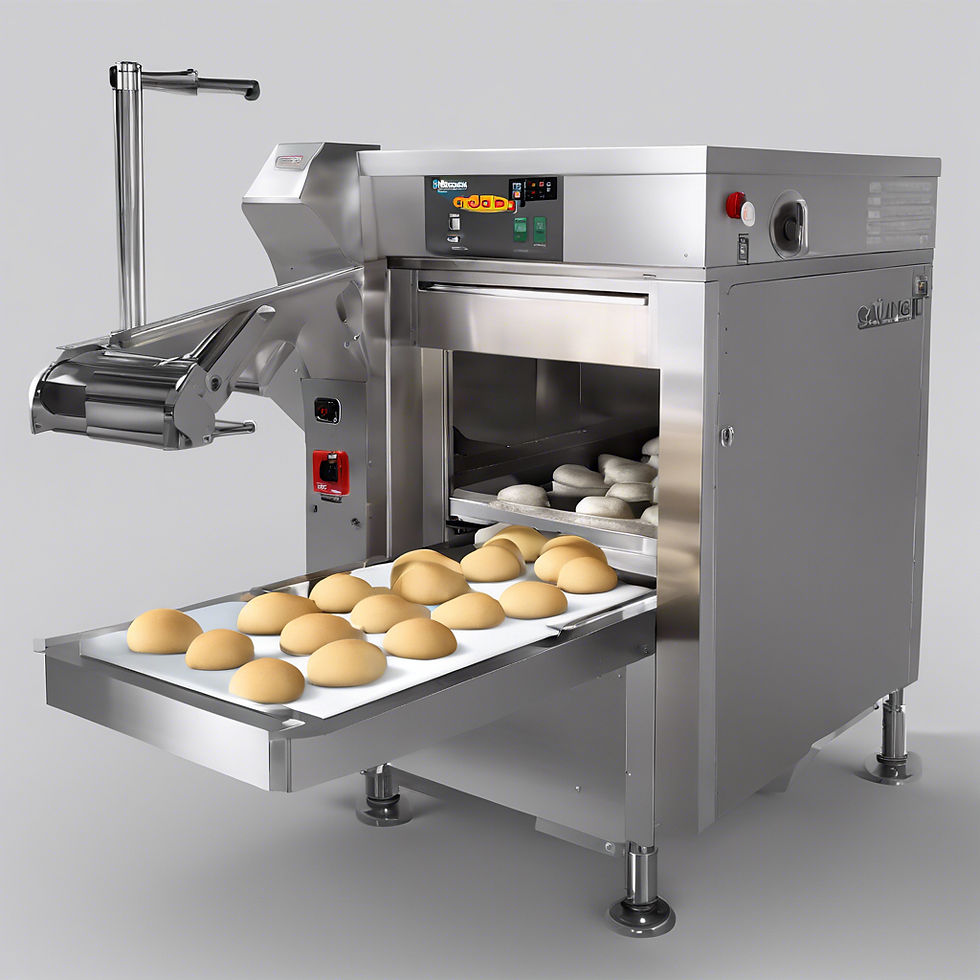Dough Ball Machines: Achieve Consistent Portioning for High-Volume Bakery Production
- Yina Huang
- Jul 5
- 4 min read
In the competitive landscape of commercial baking, consistency and speed directly impact profitability. For busy pizza chains, bustling bakeries, or high-volume food production facilities, manually portioning dough can be a major bottleneck, limiting daily throughput and product quality.
Investing in a dough ball machine can immediately streamline your workflow, boost your output, and standardize product quality, saving your bakery valuable time and reducing overhead costs.
Let’s dive into how dough ball machines work, why they matter, and practical tips to leverage them effectively in your operation.

What Exactly is a Dough Ball Machine?
A dough ball machine (sometimes called a dough divider or dough portioner) automatically divides large batches of dough into evenly sized, consistent portions. These machines typically feature adjustable settings to handle different dough weights and hydration levels, significantly improving precision compared to manual methods.
Common features include:
Adjustable dough weight settings (often ranging from 30g to 300g per dough ball)
User-friendly control panels with precise portion adjustments
Stainless steel, food-safe construction for easy cleaning and durability
High throughput rates, capable of processing up to 2000–3000 dough balls per hour
Real-World Example: Pizza Chain Efficiency
For instance, a popular pizza chain in Dubai processing over 100 kg of dough daily significantly improved their operational efficiency by installing a dough ball machine from Yuemen Baking Equipment. Previously, three bakers manually portioned dough, averaging 300 dough balls/hour with 10% weight variance. After upgrading, they consistently achieved over 1,800 dough balls/hour, each precisely at 250g (±2%), cutting labor costs and increasing daily output by 35%.
Major Benefits of Dough Ball Machines
1. Significant Labor Savings
Manual dough portioning typically takes 2–3 employees per shift, limiting production rates. A dough ball machine allows just one person to handle dough feeding, freeing others for critical baking tasks or customer interactions.
2. Perfect Dough Consistency
Evenly portioned dough results in uniform cooking and consistent product quality. Whether you're baking pizzas, burger buns, or dinner rolls, precise dough weights (±2%) reduce product wastage and boost customer satisfaction.
3. Enhanced Productivity
Automated dough dividers dramatically increase throughput. A mid-range dough ball machine can produce approximately 2,500 dough balls per hour, easily supporting daily flour usage from 25 to 100 kg, common in busy bakery scenarios.
Step-by-Step Guide to Using a Dough Ball Machine Efficiently
For optimal dough portioning results, follow these practical steps:
1. Set Up Correctly
Position your machine securely on a level, stable surface.
Ensure correct power supply (usually 220V single-phase or 380V three-phase).
2. Prepare the Dough Properly
Dough hydration should be consistent (ideal hydration ranges from 55–65%, depending on dough type).
Pre-shape the dough into manageable pieces to ease feeding into the hopper.
3. Adjust Settings Clearly
Set the dough ball weight precisely based on your desired end-product (e.g., 80g for dinner rolls, 250g for standard pizza bases).
Perform an initial test run (10–20 dough balls) and weigh samples to confirm accuracy before full-scale production.
4. Run & Monitor
Monitor the output every 15 minutes to ensure consistent portioning.
Adjust the machine slightly if dough hydration or ambient conditions change (humidity, temperature fluctuations).
Tips for Achieving Best Results
Maintain Ideal Dough Temperature:Keep dough temperature between 18–22°C to achieve perfect consistency and reliable results.
Regular Calibration:Weekly calibration of portioning weights ensures precision and avoids ingredient waste.
Staff Training:Provide basic operator training, helping staff understand machine settings and quick troubleshooting.
Common Maintenance Practices to Prolong Lifespan
Maintaining your dough ball machine ensures consistent performance and longevity:
Daily Cleaning:After each production cycle, clean the dough hopper, dividing knives, and exit chute to remove dough residue.
Weekly Lubrication:Apply food-grade lubricant to moving parts, following manufacturer guidelines.
Routine Inspections:Every month, inspect belts, bearings, and dividing blades. Replace worn parts immediately to prevent breakdowns.
Dough Ball Machines Frequently Asked Questions
Q: What dough types can a dough ball machine handle?
A: Machines typically handle various dough types, including pizza dough, bun dough, naan, pita, and even slightly enriched doughs like brioche.
Q: How much does a dough ball machine typically cost?
A: Prices for quality dough ball machines from a Guangzhou bakery equipment manufacturer range from USD $2,500–$8,000, depending on capacity, accuracy, and features.
Q: What's the ideal dough weight variance?
A: A high-quality dough ball machine maintains weight variance within ±1–3%, far superior to manual methods (±8–10%).
Q: Can dough ball machines handle sticky dough?
A: Yes, but hydration should generally stay below 70%. Slight flour dusting or oil application helps manage stickier doughs effectively.
Choosing the Right Dough Ball Machine for Your Bakery
Consider these points carefully when evaluating options:
Production Volume: Smaller bakeries (under 500 dough balls/day) benefit from compact units; larger operations should choose high-capacity models capable of 2,000+ dough balls/hour.
Adjustability: Choose machines with a wide adjustable weight range (30–300g) to handle various bakery products efficiently.
Durability & Maintenance: Opt for machines built from food-grade stainless steel with easily removable components for cleaning and maintenance.
After-Sales Support & Warranty: Reliable manufacturers, such as Yuemen Baking Equipment, provide technical support, warranty coverage, and easily accessible spare parts globally.
Real Case Highlight: Bakery in Nigeria
A large-scale bakery in Lagos replaced manual dough portioning methods with a Yuemen dough ball machine. Immediately, daily production doubled (from 4,000 to 8,000 bread rolls daily), cutting portioning time by 70%. The bakery reduced its manual labor overhead by 40%, recovering its machine investment in just eight months.
Conclusion: Upgrade to Better Productivity Today
Dough ball machines not only enhance consistency but also drive remarkable productivity improvements and profitability. Whether running a busy pizza shop, bakery, or food production facility, automating dough portioning delivers measurable efficiency gains and superior product quality.
Ready to scale your bakery production efficiently?
Contact Yuemen Baking Equipment—your trusted Guangzhou, China commercial bakery equipment supplier—for a personalized quotation or product guide.
📩 Email: kian.huang@yuementrading.com
📱 WhatsApp/WeChat: +86 188 1945 9649!



